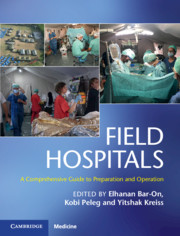Book contents
- Field Hospitals
- Field Hospitals
- Copyright page
- Contents
- Contributors
- Preface
- Section 1 History
- Section 2 Scenarios
- Section 3 Operational Considerations
- Section 4 Clinical Considerations
- Section 5 Additional Contextual Considerations
- Chapter 29 Forensic Medicine and Victim Identification in the Field Hospital Setting
- Chapter 30 Prehospital Care in the Disaster Setting
- Chapter 31 Long-term Deployment and Continuity of Care
- Chapter 32 Ethical Dilemmas in Field Hospital Deployments
- Chapter 33 Legal Issues in Field Hospital Deployments
- Index
- Plate Section (PDF Only)
- References
Chapter 29 - Forensic Medicine and Victim Identification in the Field Hospital Setting
from Section 5 - Additional Contextual Considerations
Published online by Cambridge University Press: 09 January 2020
- Field Hospitals
- Field Hospitals
- Copyright page
- Contents
- Contributors
- Preface
- Section 1 History
- Section 2 Scenarios
- Section 3 Operational Considerations
- Section 4 Clinical Considerations
- Section 5 Additional Contextual Considerations
- Chapter 29 Forensic Medicine and Victim Identification in the Field Hospital Setting
- Chapter 30 Prehospital Care in the Disaster Setting
- Chapter 31 Long-term Deployment and Continuity of Care
- Chapter 32 Ethical Dilemmas in Field Hospital Deployments
- Chapter 33 Legal Issues in Field Hospital Deployments
- Index
- Plate Section (PDF Only)
- References
Summary
Field hospitals may be deployed within the borders of the jurisdiction of the care provider or, upon official request, within a different, often remote, jurisdiction such as during humanitarian missions. The field hospital is incomplete without capabilities in the areas of forensic medicine (FM) and victim identification (VI). The specifics of what constitutes appropriate indications and circumstances warranting deployment of FM and VI services in the field hospital setting, and the necessary functions and capabilities required, is the subject of this chapter.
Keywords
- Type
- Chapter
- Information
- Field HospitalsA Comprehensive Guide to Preparation and Operation, pp. 281 - 289Publisher: Cambridge University PressPrint publication year: 2020



